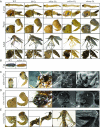Germline Cas9 expression yields highly efficient genome engineering in a major worldwide disease vector, Aedes aegypti
- PMID: 29138316
- PMCID: PMC5724270
- DOI: 10.1073/pnas.1711538114
Germline Cas9 expression yields highly efficient genome engineering in a major worldwide disease vector, Aedes aegypti
Abstract
The development of CRISPR/Cas9 technologies has dramatically increased the accessibility and efficiency of genome editing in many organisms. In general, in vivo germline expression of Cas9 results in substantially higher activity than embryonic injection. However, no transgenic lines expressing Cas9 have been developed for the major mosquito disease vector Aedes aegypti Here, we describe the generation of multiple stable, transgenic Ae. aegypti strains expressing Cas9 in the germline, resulting in dramatic improvements in both the consistency and efficiency of genome modifications using CRISPR. Using these strains, we disrupted numerous genes important for normal morphological development, and even generated triple mutants from a single injection. We have also managed to increase the rates of homology-directed repair by more than an order of magnitude. Given the exceptional mutagenic efficiency and specificity of the Cas9 strains we engineered, they can be used for high-throughput reverse genetic screens to help functionally annotate the Ae. aegypti genome. Additionally, these strains represent a step toward the development of novel population control technologies targeting Ae. aegypti that rely on Cas9-based gene drives.
Keywords: Aedes aegypti; CRISPR; cas9; germline; mutagenesis.
Copyright © 2017 the Author(s). Published by PNAS.
Conflict of interest statement
The authors declare no conflict of interest.
Figures




References
-
- Barrett ADT, Higgs S. Yellow fever: A disease that has yet to be conquered. Annu Rev Entomol. 2007;52:209–229. - PubMed
-
- Halstead SB. Dengue virus-mosquito interactions. Annu Rev Entomol. 2008;53:273–291. - PubMed
-
- Carvalho FD, Moreira LA. Why is Aedes aegypti linnaeus so successful as a species? Neotrop Entomol. 2017;46:243–255. - PubMed
Publication types
MeSH terms
Substances
Grants and funding
LinkOut - more resources
Full Text Sources
Other Literature Sources
Molecular Biology Databases
Research Materials

